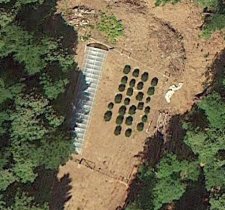Environmental Issues with Agriculture
 Google Earth Image of a cannabis grow site. The resolution of Google Earth images allowed the researchers to detect marijuana plants that were previously missed with other remote sensing techniques.
Google Earth Image of a cannabis grow site. The resolution of Google Earth images allowed the researchers to detect marijuana plants that were previously missed with other remote sensing techniques.
The UC Berkeley-based Butsic and his co-author Jacob Brenner used Google Earth imagery to locate and map grow sites (both greenhouses and outdoor plots) in 60 watersheds. Most cannabis grow sites are very small, and have gone undetected when researchers used automated remote sensing techniques, which are commonly used to detect larger changes such as deforestation.
“We chose to use fine-grained imagery available in Google Earth and to systematically digitize grows by hand, identifying individual plants. Most plants stand out as neat, clear, little circles, ” said Brenner, who is on the faculty of the Department of Environmental Studies and Science at Ithaca College. “The method was laborious — it took over 700 hours — but it proved to be highly accurate.”
Butsic and Brenner paired their image analysis with data on the spatial characteristics of the sites (slope, distance to rivers, distance to roads) and information on steelhead trout and Chinook salmon, both of which are listed as threatened species under the federal Endangered Species Act. These and other species are vulnerable to the low water flows, soil erosion, and chemical contamination that can result from nearby agriculture.
Results of the study show 4, 428 grow sites, most of which were located on steep slopes far from developed roads. Because these sites will potentially use significant amounts of water and are near the habitat for threatened species, Butsic and Brenner conclude that there is a high risk of negative ecological consequences.
“The overall footprint of the grows is actually quite small [~2 square kiliometers], and the water use is only equivalent to about 100 acres of almonds, ” says Butsic, who is in the Department of Environmental Science, Policy, and Management at Berkeley. According to Butsic, California currently has more than one million irrigated acres of almonds.









